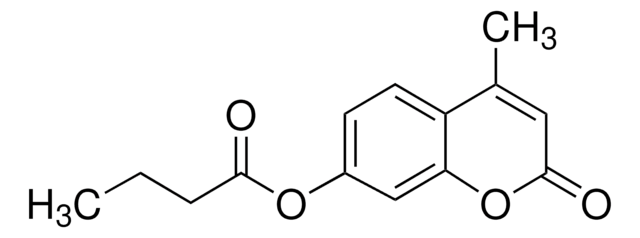69602
4-Methylumbelliferyl-β-D-glucuronide hydrate
β-glucuronidase substrate, fluorogenic, ≥99.0% (HPLC), powder or crystals, suitable for fluorescence
Sinonimo/i:
4-Methylumbelliferyl-β-D-glucopyranosiduronic acid, MUG
About This Item
Prodotti consigliati
product name
4-Methylumbelliferyl-β-D-glucuronide hydrate, suitable for fluorescence, ≥99.0% (HPLC)
Saggio
≥99.0% (HPLC)
Forma fisica
powder or crystals
Impurezze
≤0.1% free 4-Methylumbelliferone
≤15% water
Solubilità
DMSO: 50 mg/mL, clear, colorless to very faintly yellow
Fluorescenza
λex 365 nm; λem 445 nm in 0.1 M phosphate pH 6.5
Compatibilità
suitable for fluorescence
Temperatura di conservazione
−20°C
Stringa SMILE
O.CC1=CC(=O)Oc2cc(O[C@@H]3O[C@@H]([C@@H](O)[C@H](O)[C@H]3O)C(O)=O)ccc12
InChI
1S/C16H16O9.H2O/c1-6-4-10(17)24-9-5-7(2-3-8(6)9)23-16-13(20)11(18)12(19)14(25-16)15(21)22;/h2-5,11-14,16,18-20H,1H3,(H,21,22);1H2/t11-,12-,13+,14-,16+;/m0./s1
URVSQZMOFUEQAW-YYHOVTOASA-N
Cerchi prodotti simili? Visita Guida al confronto tra prodotti
Descrizione generale
Applicazioni
- as a β-glucuronidase (GUS) substrate for fluorimetric analysis of reporter gene expression in Arabidopsis thaliana
- for the fluorimetric assay for GUS activity
- to measure liposome lysis by n-octylglucoside
Codice della classe di stoccaggio
11 - Combustible Solids
Classe di pericolosità dell'acqua (WGK)
WGK 3
Punto d’infiammabilità (°F)
Not applicable
Punto d’infiammabilità (°C)
Not applicable
Dispositivi di protezione individuale
Eyeshields, Gloves, type N95 (US)
Certificati d'analisi (COA)
Cerca il Certificati d'analisi (COA) digitando il numero di lotto/batch corrispondente. I numeri di lotto o di batch sono stampati sull'etichetta dei prodotti dopo la parola ‘Lotto’ o ‘Batch’.
Possiedi già questo prodotto?
I documenti relativi ai prodotti acquistati recentemente sono disponibili nell’Archivio dei documenti.
I clienti hanno visto anche
Il team dei nostri ricercatori vanta grande esperienza in tutte le aree della ricerca quali Life Science, scienza dei materiali, sintesi chimica, cromatografia, discipline analitiche, ecc..
Contatta l'Assistenza Tecnica.











